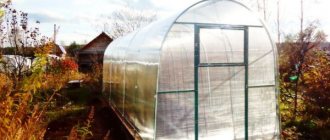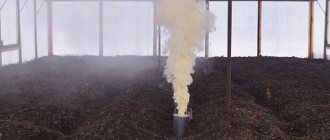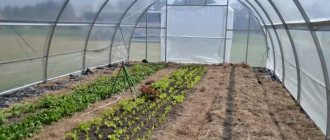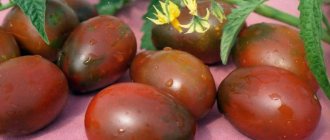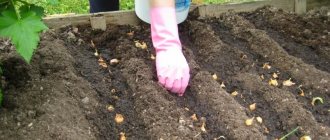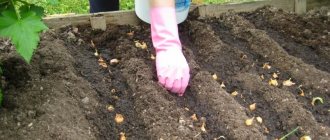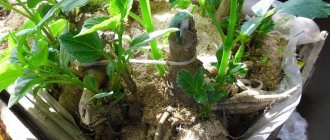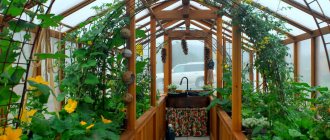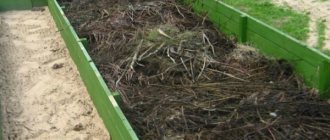Preparing a greenhouse for the new season without replacing the soil - 5 simple rules
Preparations for a new harvest of vegetables in the greenhouse must begin in the fall. This is done primarily for sanitary reasons. By the end of the season, numerous sources of plant diseases remain on the soil, metal frame structures, and working tools. A humid and warm environment, like no other, promotes the proliferation of various viruses, fungi, bacteria - sources of numerous diseases. It is their appearance that contributes to a decrease in yield and increases the time required for their treatment.
There are 5 basic rules of what you should pay attention to when preparing a garden under glass in the spring.
- First of all, cleaning up the remains of plant debris, including weeds;
- Treatment and disinfection of the inner surface of polycarbonate, metal structures, tools that were used when working with the earth;
- Throwing a thick layer of snow on the beds;
- Application of biological products with beneficial microorganisms and sowing of green manure to improve soil health;
- Prevention of possible diseases and pests.
How to disinfect soil with chemicals?
They are the most effective and fastest-acting method of protection. Many products are highly toxic and, if used incorrectly, can be dangerous to animals and humans. Hazard class 3 drugs are allowed for use on private farms. Chemicals are used at an advanced stage of the disease , or when it is very widespread.
When deciding how to treat the soil in spring or autumn, how to disinfect it, and ultimately cure it, you should pay attention to the following drugs:
- Quadris.
- Oksikhom.
- Copper sulfate.
- Copper oxide.
- Farmayod.
Phytophthora is able to quickly adapt to pesticides. Use a different type of drug for re-treatment.
Processing a polycarbonate greenhouse in spring - where to start?
If the winter has been snowy, then the first step is to carefully clear the greenhouse of snow so as not to damage the coating. And not only remove it from the roof, but also remove it from the walls at a distance of 1-2 meters. Snowdrifts outside act as a refrigerator, keeping the cold inside the greenhouse. By removing the snow from outside, the air inside will warm up faster.
If you close the doors in the fall, the soil in a closed, idle greenhouse dries out greatly during the winter. It becomes highly compacted and becomes impenetrable to both water and air. Such hard and dry soil is completely unsuitable for young vegetation. Moreover, watering, even very abundant watering and intensive loosening before planting, will not completely save the situation. In such soil, seeds do not germinate well, and seedlings are poorly accepted and can be frail and thin.
Therefore, the first thing you need to do is throw snow inside. It is applied in order to saturate the soil with melt water. In natural conditions or in the open air, plants receive rain or melt water from the soil, but in a greenhouse plants do not have this opportunity. Therefore, snow is not only thrown onto the beds, but also stored for future use, filling barrels and other containers with snow.
Melt water is the best irrigation water, just like rainwater. It is very soft, does not contain hard salts, and therefore does not alkalize the soil. It is better to take snow near the house or that has fallen from the roof. But it’s better not to take it from tree trunks or under bushes, as they themselves will desperately need it.
How to prepare the soil in a greenhouse before planting
It would be nice if you mulched the soil in the greenhouse with plant residues in the fall. Then in the spring all that remains is to chop them up and turn the soil over with a shovel.
If the beds have been sown with green manure since the fall, then they are crushed with a shovel, and then the soil is loosened with a Fokin flat cutter to a depth of 5-8 cm. Experienced gardeners note that it is not worth loosening the soil in the beds deeper, so as not to disturb the microflora of the surface layer.
By the way, earthworms greatly contribute to soil fertility. They are an important link in the ecosystem, and are even better than any fertilizer mixtures. And in order for there to be enough of them in the soil, they need to be provided with good moisture. And this is another argument in favor of throwing snow into the greenhouse in the spring.
General information
The tomato, intended for growing in a greenhouse, belongs to the Solanaceae genus and is a herbaceous plant. The root system is rod-shaped and quite well developed. The leaves of the tomato are odd-pinnate, sometimes strongly reminiscent of potatoes. The stem is erect or branched.
Tomatoes for growing in a greenhouse, depending on the variety, are also divided into types. Even experienced gardeners are confused by this classification. Stand out:
- Peruvian tomatoes;
- hairy tomatoes;
- ordinary tomatoes.
In order to choose the right variety for a greenhouse or greenhouse, you must know the basic characteristics of the plant:
- bush height;
- determinant or indeterminate type;
- timing of fruit ripening;
- versatility of using the harvested crop.
Tomatoes in a greenhouse
In addition, tomatoes can be intended for a summer or winter greenhouse. The quality and quantity of the future harvest depends on how correctly the variety is selected for specific conditions and requirements.
How and with what to treat a polycarbonate greenhouse against diseases
The next important step will be to treat (disinfect) the indoor garden from various pathogenic microflora, which most likely remain from last season. After harvesting, warm autumn and high humidity in the greenhouse allow a variety of microbes not only to survive, but also to multiply. Moreover, they can be located not only in the soil, but also on a metal frame, remaining ropes for tying or supports, as well as on shovels, forks, rakes. And if they are not destroyed, they can become a source of disease in the coming gardening season. Therefore, remove all unnecessary items from the greenhouse and treat the walls with special products. For processing use
- potassium permanganate,
- copper sulfate,
- Whiteness,
- Bordeaux mixture,
- phytosporin,
- sulfur checkers.
But before disinfecting, first wash the inner walls of the plycarbonate with soap and water to remove dust and dirt.
Liquid soap with a bactericidal effect . 1-2 tbsp. l. Dilute any liquid soap in 10 liters of water. To enhance the effect, you can add 1 tbsp to the water. l. ammonia. The resulting solution is used to wash the walls and all internal structures, and then rinse off with clean water from a spray bottle. This method makes polycarbonate transparent and accessible to sunlight.
Soap is the simplest disinfectant; it can wash away up to 70-80% of germs from a contaminated surface.
Table mustard solution . The dry powder is diluted in water in such a proportion that the solution is obtained with an intense characteristic odor and color.
Potassium permanganate. Add 2 sachets of potassium permanganate, 10 g each, to a spray bottle per 1 liter of water, shake the container so that the crystals dissolve well. The result is a fairly concentrated solution. This solution is sprayed onto the interior walls of the greenhouse and metal structures. The remaining solution can be used to treat the working tool. Potassium permanganate is an active oxidizing agent. It acts on organic matter like combustion, burns and chars it. Therefore, it is better to work with it with gloves.
Copper sulfate is a component of Bordeaux mixture, and is used as an antiseptic and pesticide. When using it, you should strictly adhere to the concentrations suggested in the instructions. Read how to properly dilute Bordeaux mixture by following the link.
And it is also very important that when preparing Bordeaux mixture, copper sulfate is poured into the liquid, and not vice versa!
Whiteness is used as a preparation that contains bleach. It also has destructive properties for many bacteria. a greater is required . However, it should be noted that chlorine is a volatile substance, and when working in it you must be careful and protect your respiratory tract by wearing a protective mask.
Soil preparation before planting - treatment with phytosporin
When treating the soil with disinfectants, in addition to the death of pathogenic bacteria, beneficial bacteria also die. To restore the microflora, gardeners spill the soil with a solution of phytosporin. However, when using this remedy, many of them make mistakes, as a result of which they do not get results from using the drug.
The active component of Fitosporin is live spore bacteria. They are able to suppress the proliferation of pathogenic microflora in the soil, thereby making it healthier. The spores do not lose their activity at temperatures from -50 to +40ºС. However, at low temperatures (below -14ºС) they lose their activity, fall into suspended animation and simply do not work.
When is the best time to treat the soil with biological products? All biological products, including Fitosporin, feel better and work in warm soil. And if the air in the greenhouse has warmed up to +20-25ºС, this does not mean that in March the earth has already become warm. Therefore, the optimal period for using biological products will be:
- after disinfecting the soil at least a week,
- when the soil warms up to +15-20ºС,
- no earlier than 1-2 weeks before planting the seedlings in the greenhouse.
It is most convenient to buy Phytosporin in the form of a paste, in a package weighing 200 g. The stock solution is prepared in a ratio of 1:2, that is, 1 part of the product is diluted in 2 parts of water. The product is mixed well to obtain a homogeneous solution. The mother liquor can be stored indefinitely in the basement, cellar, barn until autumn.
To prepare the working solution, 1 tbsp. l. the mother plant is diluted in 10 liters of water, and this solution is watered from a watering can on the bed, previously loosened with a flat cutter. 10 liters of working solution are poured onto 2 square meters. m.
Planting material
It is very important to plant healthy seedlings in the greenhouse or sow seeds that are not infected with diseases. Even the best soil, capable of resisting pathogens, can suddenly contain so many pathogens that it cannot cope. Therefore, you should not test the disinfecting properties of soil.
To treat the seeds, it is enough to soak them in a weak solution of potassium permanganate or a soap suspension (the soap should be laundry soap). Then the seed should be rinsed and dried. It is recommended to sow seeds for seedlings in a high-quality mixture.
Soak the seeds in potassium permanganate to disinfect
Important! Contrary to popular belief, most soil mixtures offered by specialty stores are safe from the point of view of contamination by harmful microbes and eggs of pests.
You can make planting mixtures yourself by preparing leaf, turf, coniferous soil and sand in advance. All ingredients of the future substrate are well frozen in winter. If you have doubts about the quality, you can heat small amounts of soil in the oven.
Land for seedlings
Thus, creating a healthy microclimate in a greenhouse and growing strong and healthy plants is quite possible.
The conditions necessary for this will be created by:
How to treat a greenhouse against spider mites in the fall
Spider mites are a very dangerous, voracious pest that can easily destroy all your plants and ruin your harvest, as it spreads very quickly throughout the greenhouse. Read more about how to deal with it here.
Healthy soil and the same plants on it successfully resist the moderate onslaught of pathogens that are constantly present in the atmosphere and earth. Therefore, there is no need to worry about the harvest.
What to plant in a greenhouse before planting tomato and cucumber seedlings
Gardeners most often use a greenhouse to grow tomatoes, peppers, eggplants, and cucumbers. However, their seedlings are planted no earlier than mid-to-late May. For almost more than a month, after the snow melts there, the land will be empty. But this time can be used profitably.
First, sow green manure. This is a complete substitute for nitrogen fertilizers, and the plants do not fatten, as with an overdose of organic fertilizers. Therefore, after sowing, for example, mustard, additional nitrogen fertilizing is not carried out. The nitrogen that remains after green manure is quite enough for the first time for young plants. Later, when you transplant vegetable seedlings, you need to loosen the soil again using a flat cutter.
Secondly, so that the land does not become empty, sow fast-growing cold-resistant crops: radishes, dill, lettuce, onions for greens. They can be planted at the same time as green manure by making shallow furrows. And the green manure seeds can simply be scattered on the ground and lightly covered with a rake. By the time the seedlings are planted, these green crops will already give you your first harvest.
Making compost
To plant tomatoes, it is best to use homemade compost. It can be prepared during the summer using any modern biological product. For example, you can take the biological product Ekomik Urozhainy. It accelerates the maturation of compost. During the summer and autumn, waste accumulates at the summer cottage:
- tops;
- leaves;
- cut shoots;
- mown grass.
They do not need to be destroyed; they are excellent raw materials for making quick compost. Biological waste must be placed in loose piles. Water the heaps with a solution of the biological product every time a new layer 20-30 cm thick is formed.
To prepare 10 liters of solution you will need 100 ml of the drug. It takes from 1.5 to 3 months for such compost to mature. This compost can be added to the holes in the spring; it is an excellent organic fertilizer for growing tomatoes indoors. It is enough to add from 5 to 10 kg of homemade compost per square meter.
See also
Rules of agricultural technology for growing tomatoes in open ground and greenhousesRead
After the beds are filled with compost, they are watered with a liquid solution of the biological product a week before sowing. Heat water (10 l) to a temperature of 25 °C, add 100 ml of “Ecomik Harvest” product to it. For greenhouse use, the consumption rate is 1 l/m². For disinfection, all supporting structures of the greenhouse are treated with this solution.
